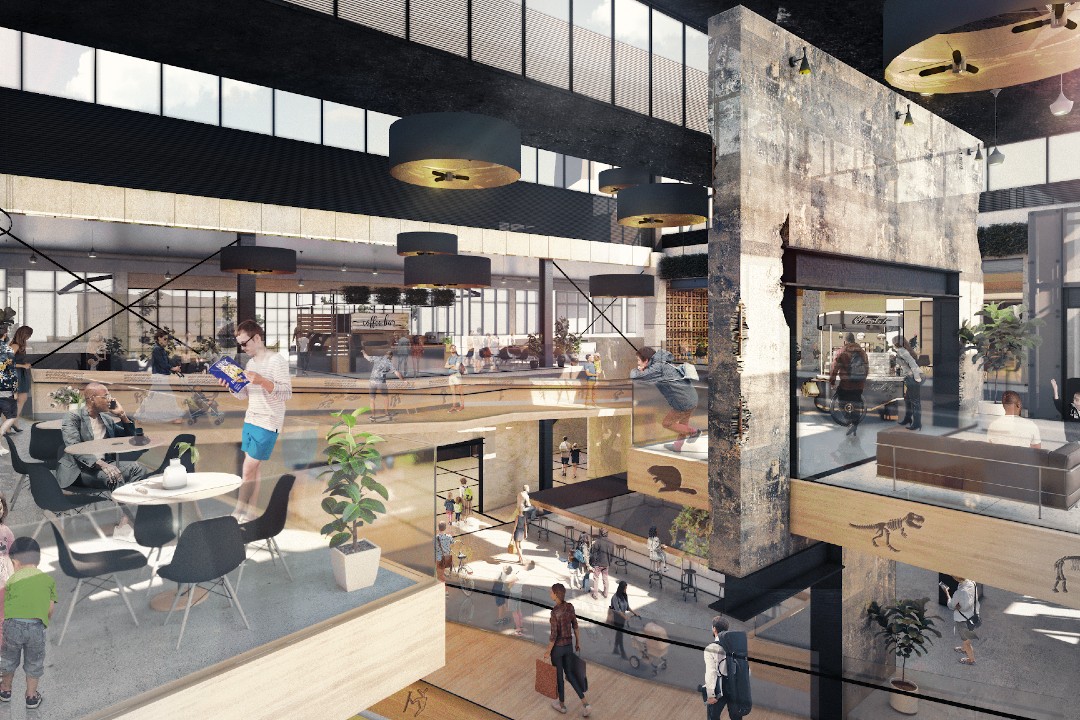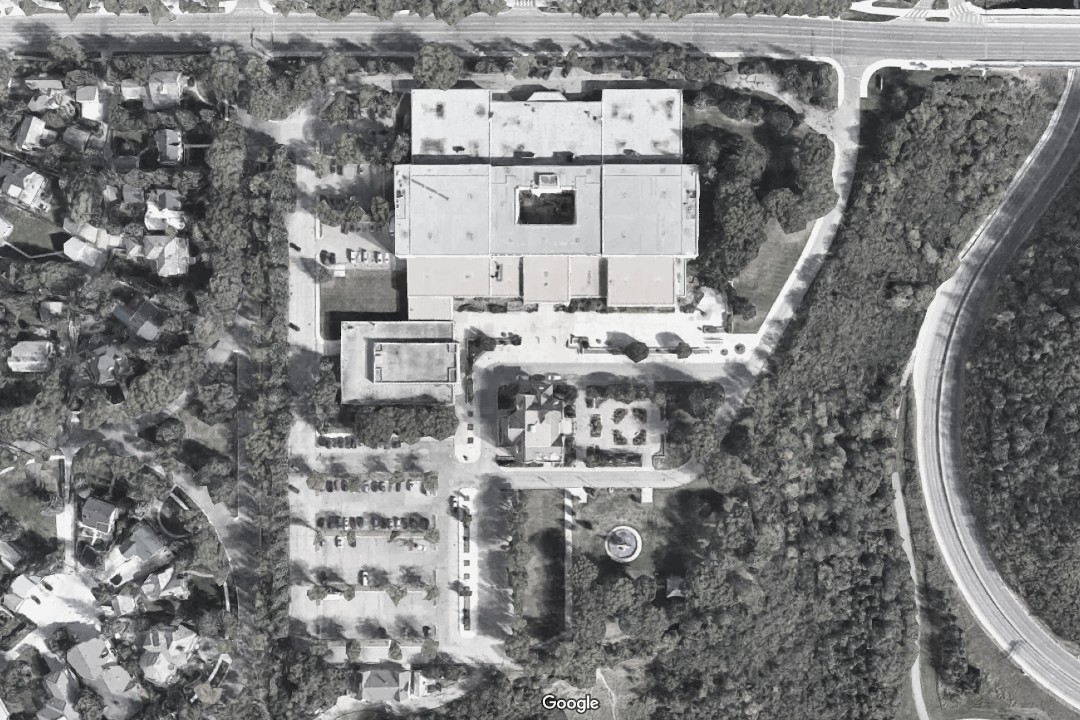Despite the province's ongoing work to demolish the former Royal Alberta Museum in Glenora, the heads of Beljan Development and Reimagine are campaigning to save it from the wrecking ball.
Their big idea is to repurpose rather than demolish it — and stop letting the existence of asbestos in the building derail a discussion of saving it.
"Leasing the building to a known, competent, and capable development and design team is a lot less risky than taking on a demolition project where there's all sorts of things that could surprise you," Vivian Manasc, founding principal architect at Reimagine and a member of the Alberta Order of Excellence, told Taproot.
Reimagine and Beljan Development both have experience rejuvenating historic buildings. They held an event that Taproot attended on Nov. 21 to discuss their pitch — which they have shared with the Alberta government — to preserve the nearly 200,000-square-foot building, upgrade its infrastructure, and prime it for new purposes like retail, food service, recreation spaces, and cultural facilities. But the team isn't locking itself into just one course.
"The art of of repurposing an asset is just understanding how you create that flexibility, how you create all the pieces that tenants or different uses will require," Ivan Beljan, the owner of Beljan Development, told Taproot. "I think you just have to understand what the market is looking for today, but also be adaptive enough that you can accept other things that you may not have even envisioned there."
Opened in 1967 as the Provincial Museum of Alberta, the original RAM was funded by the federal and Alberta governments to commemorate Canada's centennial. Its six-year construction cost $8.5 million, or between $75 million and $88 million in today's money. The building was renamed during Queen Elizabeth II's visit in 2005, her last trip to Alberta. It was shuttered 10 years later. The new Royal Alberta Museum opened downtown in 2018 and cost nearly $376 million. Architectural fans love the former RAM for its Tyndall limestone exteriors, marble-lined interior, and the reproductions of Indigenous petroglyphs from Writing-on-Stone Provincial Park, which are carved into its south-facing walls.
"You couldn't possibly build that building now," June Acorn, a nearby resident and advocate for saving the building, told CBC in 2016, when demolition was first discussed.
Asbestos has been raised as a challenge to save the old RAM, but it's not a barrier for Beljan and Manasc. "That's actually the least of our worries," Manasc said. "It's just the thing that you have to do, just like washing the floors. Nobody talks about washing the floors."
In fact, the province has started asbestos abatement work at the former RAM and is also removing artworks from the premises as it pursues its demolition options, Manasc said. But if that makes it sound like the wrecking ball is already swinging, Manasc said that's not the case.
"The earliest a demolition would actually begin would be May," she said, estimating this based on keeping watch on the process. Manasc noted the due date for consultant WSJ to prepare tendering documents (invitations for bids by contractors) is at the end of February, and there is a two-month average between a tender and work.

Beljan Development and Reimagine want to simultaneously preserve and update the former Royal Alberta Museum building in order to save its historical significance and provide it with new purpose. (Supplied)
Manasc said the tendering process may prove demolition is more expensive than the province anticipates. As CBC Edmonton reported, the province's current estimate for the work is from $22 million to $48 million, which it would trade off for the $700,000 it spends annually to maintain the building.
The true cost of demolition won't be known until the province receives its bids, both Manasc and Beljan said.
"Once that information is put together and costed out, that may cause people to rethink (demolition)," Beljan said. "We're hoping to intercept well in advance of that and push other options here, but lots can happen."
These interception efforts made news in mid-November, when a representative for the ministry of infrastructure said the province remains committed to demolition and creating a green space on the site. But the team's quest is nothing new. Beljan and Manasc said conversations go back to 2020, when a request for proposals that was not limited to demolition appeared. That's when Jason Kenney was still the premier. Talks stalled out in 2022, when Premier Danielle Smith replaced Kenney. Beljan said the new contacts in government decided to shelve conversations on redeveloping the old RAM and tell them they would engage again.
Those conversations could resume again soon. Brandon Lunty, the United Conservative Party MLA for Leduc-Beaumont, attended the Nov. 21 event, hosted by the Edmonton Heritage Council, where Manasc and Beljan advocated for repurposing the old RAM.
"If we save money and get to do this, I mean, it just seems to make a ton of sense," Lunty said at the event. "I'm definitely going to take this away to my colleagues."
Lunty added that his first question is what will go inside the building, but believes Manasc and Beljan's team will "fill in the blank canvas." As of Nov. 26, Reimagine and Beljan Development had not heard anything further from the province.

This rendering is just one way the old Royal Alberta Museum building might be updated for new uses. If Beljan Development and Reimagine convince the province to give them the reins, it may be home to retail, dining, recreation, and cultural spaces. (Supplied)
Some work that Manasc and Beljan's team have in mind for the old RAM includes replacing the mechanical-electrical systems, modifying and repairing the structure, and upgrading its envelope (the components that keep heat out or in), Manasc said. Beljan added that improvements also include creating a "canvas" for potential occupants by considering the layout, accessibility, signage, and how different components of spaces fit together overall.
On the financial front, Manasc and Beljan said a potential arrangement between themselves and the province is malleable. One proposal is a 99-year lease, but the team is looking for a solution that serves both itself and the province. The investment in upgrades and repurposing could be various ratios between the team and the province so long as the ability to recoup it is there.
Established track record
Reimagine and Beljan Development both work at revitalizing buildings. Reimagine worked on the Mercer Warehouse downtown, Procura WSP Place, and buildings for governments at every level in Canada. Beljan, meanwhile, revitalized the Oliver Exchange, Substation 600, the Metals Building, and numerous properties in Old Strathcona.
"I've made a business out of trying to save buildings," Beljan said.
At the event, he added: "The neat part is, when you're able to bring an old building back to life and it has a new use, it still has the story there. You cannot recreate that in a new building. New buildings have yet to create their own story."
The old RAM grounds remain home to the province's Government House, which opened in 1913. Today, it is mostly an events venue, destination for public tours, and a repository for art and artifacts. Government House is not up for demolition.
A blog post by Connor J. Thompson for the Edmonton Heritage Council offers a detailed look at the original RAM's legacy, and also makes a case for its salvation.
